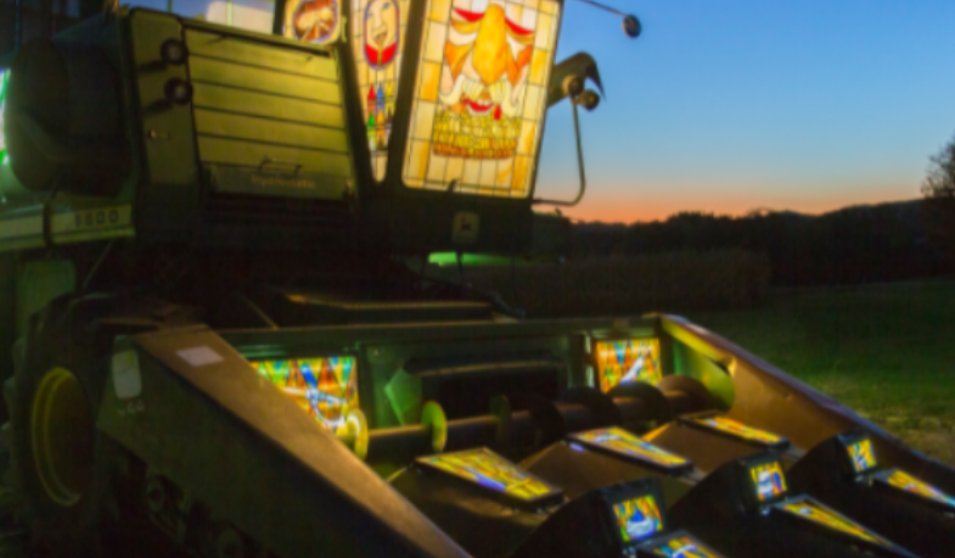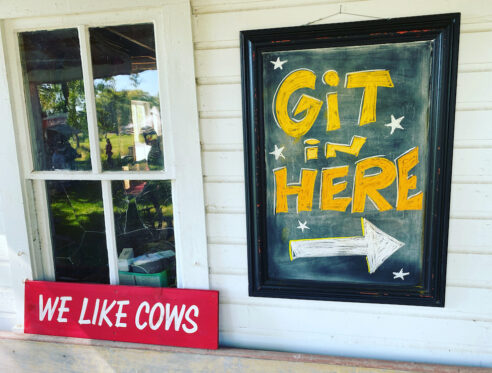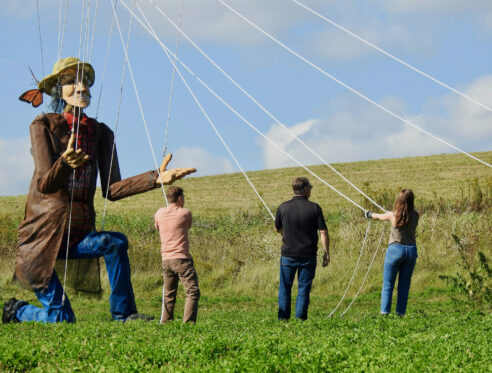Art, music, and poetry in the Wisconsin countryside are nothing new. Fiddles stirred the air of 19th century lumber camps. Our great grandmothers translated rural evenings into Nine-Patch and Double-Wedding Ring patterns. They knew the language of the running stitch, the value of passing beauty down. Walk through any rural cemetery and conjure up the ghosts from beneath the most weathered tombstones, and you’ll be hard pressed to find one who can’t recite whopping passages of Longfellow or Tennyson.
Last October, navigating the 50 mile loop (the Farm/Art DTour) out from Reedsburg during the annual Fermentation Fest, I witnessed the continuation of this tradition of integrating culture and agriculture, human creativity and natural beauty. On a grassy hillside I listened to a wind-aided aria sung from the back of a hay wagon by a soprano wearing a skirt of corn husks. In a stubbled field I poked around a John Deere 6600, the metal panels of which had been replaced by stained glass. Further along, I stopped to watch children along a ridge flying kites shaped and spotted like Holsteins.
It’s a drive that’s stayed with me, though more accurately, it’s the stopping. Too often, accelerating along beltlines, cruise controlling the interstates, we’re in a state of mini-jet lag (or Toyota lag, maybe). This dis-orientation is obvious when we fly across time zones, but a more insidious version happens whenever we experience forests, hills, bluffs, and farmsteads as variegated blurs, entire counties as 70-mile-an-hour winds. In the hurried, miraculous nowhere land of interstate travel, you can follow directions beamed down from 12,000 miles in space, calculating your position to within a stone’s throw of any hill or molehill in Wisconsin, and still have no earthly idea where you are. You’ll be at the proper coordinates, but with little notion of who lives there, or why, their hearts and minds, the relative state of local wonder.

It’s not until we’re prompted to stop, turn off the engine, unclench the jaw and shoulder muscles and begin to see and feel in human time, or something older, that we’re anywhere at all. It takes awhile for the landscape’s blur to redefine itself into maple, poplar, beech; the slopes and streams to reveal themselves. Ironically, it’s only when we stop, we’re able to understand that land itself is motion—waves of hills, water chiseled creek beds; every inch of soil occupied with molecular hustle, each handful alive with more organisms than there are people on earth—all moving, degenerating, regenerating. It’s only when we stop, we’re able to hitch onto an older, sustaining motion.
What does this have to do with art? Exactly what is the point of a soprano singing from a hay wagon?—Well, there’s beauty, which is point enough, but we’re also reminded that even the most sophisticated voice springs from flesh and bone, resonates with the pulses and rhythms of landscape where song preceded us by a long shot. A stained glass combine? Again, strangely beautiful, but also, placing stained glass, typically associated with places of worship, onto a John Deere hints at something worthy of adoration in the field itself, as well as the acts of cultivation and harvest. The point of cow-shaped kites? Aside from the faces of children, we’re reminded of the connection between wind, sky, grass, and the creatures who feed us. What starts out as gawking, ends up illustrating, through the medium of exhilaration, just how much is tethered to sunlight.
Art amplifies what landscape quietly asserts—the world rises in wildly imagined forms, falls, replenishes itself, and our individual fates are braided into the loop. Art, like forests or farms, bears crucial, eloquent witness to time and place. Our great grandmothers made quilts to keep us warm, but also made them beautiful, for without that flourish, it’s a frail flame we pass from one generation to the next.
Of course, thousands of years before fiddles and quilts there were pictographs, petroglyphs, pottery, songs, drums, flutes, and dances expressing what it means to inhabit and be inhabited by this place. My favorite rural art installation, in fact, is not far from Reedsburg. It’s a 214 foot long effigy mound in the shape of a human (or god, or spirit?). The Man Mound is a thousand years old, give or take a few centuries, the only human shaped mound surviving in Wisconsin. There’s a lot we don’t know about this figure, but it’s not hard to catch the general drift of a magnified human form collectively shaped from local soil.
I’m sitting a few feet from the Man Mound as I write. It’s a spring day, and at the moment the mound is covered in several thousand wild violets. A few fiddleheads unfurl near his shoulder; there’s a smattering of dandelions, a sparse traffic of moles. I’m blind to most of what’s here, the trillions of organisms animating his shape (as well as my own). After a couple of hours, however, I do feel myself beginning to arrive. The only visitors have been an indigo bunting, an oriole, a few crows, a fox squirrel, and a yellow-shafted flicker, though I expect they had other business in the neighborhood.
It’s been a very long trek for human imagination, arising from, and striving to reconnect us to the world, that ancient ongoing loop. I’m glad to see it continue here, nourished by events like Fermentation Fest. Among natural and cultivated landscapes, it’s good there are supplementary wonders, strange and lovely enough to make us turn off our engines, unplug our ears, step back into the world we never left, but nevertheless have been partially absent from. I’d travel a long way to be stilled by an ancient effigy, or hillside aria, or holy combine.
Sitting here by the Man Mound, I find it interesting that although he’s occupied this place for a millennium, he’s depicted in motion, heading west, like me. That he’s earth, like me. Frankly, we’re both a little worse for wear. A county road has slashed him just below the knees. There’s been erosion (in both of us), and according to the historical marker, the mound barely dodged the plow a number of times. After all these years, it’s a wonder he’s survived at all. The longer I sit here, the less coincidental it seems, that it’s by cultivating wonder, as well as land, up from dust and back again, the rest of us survive.
“Cultivating Wonder” was originally printed in the 2014 Fermentation Fest Event Guide.
Max Garland is a former rural letter carrier and author of The Postal Confessions, winner of the Juniper Prize, and Hunger Wide as Heaven, which won the Cleveland State Poetry Center Open Competition, as well as a chapbook Apparition. His work has appeared in Poetry, New England Review, Gettysburg Review, Best American Short Stories, and other journals and anthologies. He has received a NEA Fellowship for Poetry, Michener Fiction Fellowship, a Bush Literary Fellowship, the Tara Short Fiction Prize, and fellowships from the Wisconsin Arts Board in both poetry and fiction. He lives and teaches in Eau Claire, and is the Poet Laureate of Wisconsin.



